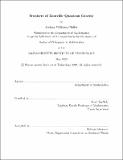Frontiers of Liouville quantum gravity
Author(s)
Pfeffer, Joshua William.
Download1191267534-MIT.pdf (5.797Mb)
Other Contributors
Massachusetts Institute of Technology. Department of Mathematics.
Advisor
Scott Sheffield.
Terms of use
Metadata
Show full item recordAbstract
Abstract This thesis studies a universal model of random geometry in two dimensions called Liouville quantum gravity (LQG). LQG was originally described heuristically by physicists, and mathematicians have grappled with the challenge of defining it rigorously and analyzing its properties. We investigate elements of the theory of LQG that are still poorly understood, often even from physicists' heuristic perspective. -- We analyze LQG as a metric space. We prove results necessary for the construction of LQG as a metric space, and prove fundamental estimates for these distances. We prove the most natural formulation of the Knizhnik-Polyakov-Zamolodchikov (KPZ) formula, which relates Hausdorff dimensions of sets with respect to the Euclidean and LQG metric. And we prove upper and lower bounds on the Hausdorff dimension of the LQG metric. -- We propose a model for LQG with matter central charge in (1, 25). We introduce and justify a model for LQG for matter central charge c in the range (1, 25), a regime whose probabilistic and geometric behavior is much less well-understood than the classical regime c < 1, even from a physics perspective. -- We rigorously link the determinant of the Laplacian to the definition of LQG and to the mass of Brownian loops. We give a mathematically precise interpretation of physicists' original definition of LQG in terms of the determinant of the Laplace-Beltrami operator ("Laplacian"). And we rigorously relate the zeta-regularized determinant of the Laplacian to the regularized mass of Brownian loops on the surface. -- We apply the theory of LQG to answer open problems in other areas of probability. We apply tools from LQG to answer open problems about the connectivity of the adjacency graph of complementary connected components of a Schramm-Loewner evolution curve. And we prove a precise asymptotic growth exponent for external diffusion-limited aggregation in the setting of a spanning-tree-weighted random planar map-the first result of its kind on any class of graphs.
Description
Thesis: Ph. D., Massachusetts Institute of Technology, Department of Mathematics, May, 2020 Cataloged from the official PDF of thesis. Includes bibliographical references (pages 317-336).
Date issued
2020Department
Massachusetts Institute of Technology. Department of MathematicsPublisher
Massachusetts Institute of Technology
Keywords
Mathematics.